 Hana Warner
Hana WarnerHome Institution: College of William and Mary
Status: Sophomore, Expected Graduation Date: May 2020
Field of Study: Physics and Mathematics (applied)
Host Lab in Japan: Osaka University – Inst. of Scientific & Industrial Research, Advanced Electronic Devices, Sekitani Laboratory
Host Professor: Prof. Tsuyoshi Sekitani
Research Abstract and Poster: Fabrication of Wearable Heart Monitor Using Organic Amplifier Circuit (PDF)
Why Nakatani RIES?
The Nakatani RIES Fellowship provides an exciting opportunity to spend the summer in Japan while conducting cutting edge research. I am eager to explore different areas of physics and engineering research than that which I am exposed to at my home institution while also exploring the intersection of research and culture. Research is an international, collaborative endeavor, and it is important to understand the similarities and differences between how research is conducted in different places to better collaborate with other scientists.
I am also excited by the opportunity to learn more about my family’s culture while in Japan this summer. My great-grandparents came to America before WWII, but I have many family members that still live in Japan. I hope to have the opportunity to meet them and learn more about my heritage while in Japan this summer. RIES will be invaluable in gaining research and collaboration experience and familiarity with Japanese culture: but, beyond this, it will provide countless opportunities for growth and understanding as I learn to navigate a new culture and environment while studying topics I am passionate about.
Goals for the Summer
- Hone research skills and learn about new areas of physics and engineering
- Foster meaningful and lasting relationships with other Nakatani Fellows and colleagues
- Achieve conversational proficiency in Japanese
- Explore family heritage
Meaning of Nakatani RIES (Post-Program)
The pre-departure orientation feels like a distant blur, but something that has stuck with me throughout the summer has been Sarah’s advice to “just say yes.” This is something I’ve reflected on a lot throughout the summer, and I am thankful to have had her voice in my head through every opportunity I’ve had this summer.
I never expected the profound impact that this fellowship would have on me. With each “yes,” I discovered a burning interest in organic electronics, a confirmation that I absolutely want to go to graduate school and keep conducting physics research, and developed lifelong friendships with my lab mates and the other fellows. I hiked the highest mountain in Japan, made friends in a language I just began learning months ago, and explored until my shoes fell apart. This program enhanced my passion for science while broadening my global perspective and understanding of Japanese culture. I am thankful for the opportunities it has provided me, and plan to continue to learn about organic electronics and study Japanese—I look forward to catching up with the people that I have met at an international conference sometime in the future (or hopefully, on a return trip to Japan!)
Research Internship Overview
This summer, I fabricated a heart rate monitor using an organic amplifier circuit. Our device utilizes an electrode deposited on either side of a piezoelectric film (PVDF) to detect pulse. These signals are then amplified by a Pseudo-CMOS circuit and sent to a wireless module so they can be transmitted and processed. I loved working on my project: prior to this summer, most of my research experience has either been in optics or computation based, and it was really cool to be able to work on something very applied. I enjoyed learning the fundamentals of the electronic components, and it was fun to figure out how to put the device together during fabrication and integration. My experience confirmed that I want to go to graduate school: while I don’t know what field I want to specialize in, I definitely don’t want to leave organic electronics behind. Hopefully I can combine my interests in electronics and optics into something like photonics or optoelectronics, but regardless I will continue to learn as much as I can about all of these fields!
The Sekitani Lab is pretty big—there are about ten students, twenty full time researchers and engineers, and four professors in charge of each focus of the lab: materials, process, and integration. Then there’s Sekitani-sensei himself, who oversees all functions of the lab. The group is big, but everyone is always willing to help and collaborate. Most people have a project that they work on with one of the professors, but, since we all have similar goals in trying to understand and develop new devices, it is common for members to be fabricating arrays simultaneously or teaching others the process for creating and characterizing a device layer. Since our group is so big (and people are very busy), spending time with people outside of lab was very special and lots of fun. I’m very happy that I had the chance to get to know and meet with everyone in the lab. I am also very thankful for my mentors. I worked very closely with one of the graduate students, Sugiyama-san, and learned so much from him. I’m happy that I had an opportunity to work with one of the students in addition to Uemura-sensei since I was able to learn more about graduate school in Japan and the experiences of Japanese students. We got to learn and discover some things together, so the project was really exciting for both of us.
Daily Life in Japan
My weekdays were pretty uniform—I spent most of the day in lab fabricating, testing, and characterizing my devices or reading about organic electronics. I usually went to lunch with a few other people in my lab each day, and fell into a regular routine with the other international researchers, since most people brought their lunch and ate at their desks. At the end of the day, I would go home and make dinner and then either go grocery shopping, walk around, or do work. I had fun experimenting with different food I could make on the hot plate and microwave in our kitchen and chatting with the other people in my shared house. My weekends were much more varied and spent exploring: I don’t think there’s a single day that I walked less than eight miles, and sometimes walked as far as twenty. I’m glad that I had the chance to see so much of the areas I visited!
Experiences with Japanese Culture
During our first few weeks in Japan, we spent a lot of time learning about Japanese culture in seminars and excursions. However, I think I started to really understand the culture sometime after I left for my lab. It was in Osaka that I really started to understand the differences between Japanese and American values, and started to recognize the differences during our weeks of orientation. It was interesting to be able to identify these differences, and startling to come back to the US and notice the reverse.
- My favorite experience in Japan was…coming back together with everyone during the mid-program meeting. There are a bunch of pathways that cross the Kamo River, and sitting in the middle of the river with the other fellows was the most at peace I had been in a long time.
- Before I left for Japan I wish I had…studied Japanese more. The first few weeks are a whirlwind of jet lag, class, excursions, and seminars, and it definitely helps to have a little bit of a baseline in basic Japanese and useful kanji.
- While I was in Japan I wish I had…gone to see fireworks—I went to a lot of festivals, but the first time I saw fireworks was when we were about to start climbing Mt. Fuji (which was still really cool, but I hope to be able to see them closer up in the future!)
Excerpts from Hana’s Weekly Reports
- Week 01: Arrival in Japan
- Week 02: Language Learning & Trip to Mt. Fuji Lakes
- Week 03: Noticing Similarities, Noticing Differences
- Week 04: First Week at Research Lab
- Week 05: Cultural Analysis – Life in Japan
- Week 06: Cultural Analysis – In the Lab
- Week 07-08: Overview of Mid-Program Meeting & Research Host Lab Visit
- Week 09: Research in Japan vs. Research in the U.S.
- Week 10: Reflections on Japanese Language Learning
- Week 11: Interview with a Japanese Researcher
- Week 12-13: Final Week at Research Lab & Re-Entry Program
- Final Research Overview and Poster
- Follow-on Project
- Tips for Future Participants
Week 01: Arrival in Japan
Before leaving for Tokyo, we all completed an intercultural effectiveness survey and discussed American and Japanese core values, comparing and contrasting their similarities and differences. During our first week in Tokyo, I found myself frequently reflecting on our seminar. Standing in line on the subway escalator, I notice people patiently lining up to board the train and quietly pack in tightly, but leave space for those around them. This harmony on the Tokyo subway contrasts with my frequent experiences on the DC metro where people talk loudly on the phone wearing backpacks and taking up multiple seats to discourage others from sitting near them. I have become more aware of the space that I occupy and the noise that I make, and how I can contribute to the harmony of the community rather than detract from it.
I have also noticed the American urge to “always be doing something.” In every free moment we have, we’re immediately off to a new destination and plotting how to get there as quickly and efficiently as possible. We’re eager to explore our new environment, and in this way we have had some incredible experiences. However, some of my favorite experiences so far have been while walking around and getting lost, only to find beautiful shrines, peaceful parks, and delicious food. The best plan is sometimes no concrete plan at all but a willingness to be flexible.
This summer, I hope to form lasting relationships with my lab mates, students at Osaka, and the other fellows. I will accomplish this by “saying yes” and not being afraid to reach out to the friends I make while we are no longer together. I hope to get to know people in Osaka by being an active participant in laboratory activities and the international student center to work on my Japanese language skills and facilitate communication with my lab mates and students at Osaka University. Additionally, I plan to join a few student organizations at Osaka University to meet other students, and will continue to reach out and maintain contact with them after I have to leave the campus at the end of the summer.
I was nervous stepping off the plane in Houston. However, my nerves quickly faded when I met Kaitlin at the airport and we excitedly began discussing the summer (and dinner plans, discovering a shared passion for food that has already driven a number of adventures in Tokyo). After arriving at the hotel, we were soon joined by the other fellows, found food, and started to explore Houston. I was struck by how comfortable I was around the other fellows. We each fed off of each other’s’ enthusiasm, leaving us eager to start our pre-departure orientation and even more excited to get to Tokyo.
When we finally got to Brockman Hall on Thursday morning, we excitedly engaged in discussions on Japanese culture and language and international research. Ozaki-sensei gave an incredibly useful talk on Japanese culture and a brief introduction to the language with a fun song. Professor Kono’s talk on international research was beneficial for gaining a better understanding of the lab culture, and Sarah-san facilitated numerous useful cultural discussions. The seminars were helpful both as a learning tool and for getting to know the other fellows better.
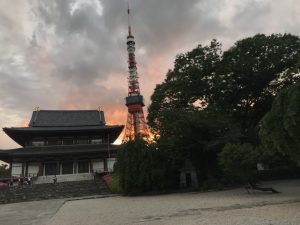
When we finally arrived into Tokyo, I was struck by how clean, quiet, and green the city is. Back home in Washington, D.C., a cacophony of honking cars, noisy pedestrians, and the rattle of street music greets every step. Cups and wrappers litter the street, and, while there are some parks, the majority of the city is dominated by buildings and concrete. I’ve heard three car horns during my first week in Japan, the walk to classes and around the city is always quiet, and the streets are devoid of trash. Trees are everywhere, and we constantly stumble across parks (often nearby the local shrine). Tokyo is not a city that intimidates with a ceiling of skyscrapers, but greets with large open sidewalks and a respectful populace. The wa, or harmony, of Japan that we discussed in the pre-departure orientation is very apparent in the peacefulness of its streets. I was surprised by how safe and comfortable I felt in such a large city, and it is very different from those I’m used to.
This is not to say that my first week in Japan hasn’t been challenging: I am constantly making efforts to not disrupt the wa by being a “loud American,” walking on the wrong side of the street, or trying to find the quickest route while those around me patiently wait for the rest of the crowd to find their way. Further, I had little experience with Japanese language prior to coming to Japan beyond words and phrases I learned on my own. While it is possible to get by in Tokyo with minimal Japanese and some pointing, I have been doing my best to improve my Japanese so that I am better able to communicate with those around me. Our language classes have been incredibly helpful for this.
We have class every morning, where we learn Japanese sentence and grammar structures, vocabulary, and phrases. Our sensei’s are incredibly helpful and always willing to answer questions and offer advice. While we go through a lot of material quickly, I do my best to remember everything we learn by making flashcards I review on the subway and trying to speak in Japanese as much as possible. This weekend I was able to have a full exchange in Japanese, which, while small, leaves me optimistic about continuing to improve my language skills throughout the summer.
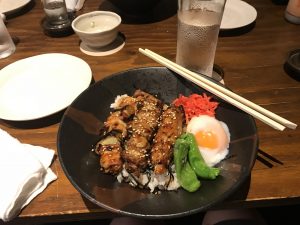
Outside of language classes, we have gone on numerous exciting excursions and had many interesting seminars. Early in the week, we had the opportunity to go to the University of Tokyo to tour labs and meet students. They shared some cool stories about university in Japan, tips on things to do in Tokyo, and we swapped interests and hobbies. It was also really interesting hearing about their research, and made me realize how much I miss being in lab. I was so excited to be around research, and while I could easily explore Tokyo while learning Japanese for forever, I also can’t wait to start working in lab again.
I was so excited when I realized we were learning Taiko. I remember seeing Taiko for the first time with my family at a festival in Seattle and being enthralled by the energy of drummers. Our sensei’s spirit was no different, and it was awesome learning the traditional drumming style and seeing him perform after he taught us.
We also had the opportunity to learn about Sumo, the Earth Simulator Super Computer, and go to the Ikebkuro Life Safety Training Center. I loved learning about the history of sumo and the development of modern supercomputers. It’s amazing how they can be used to detect and analyze natural disasters. Learning about the recent earthquakes in Japan and participating in safety training was incredibly sobering. There are many instruments in place to facilitate the safety of individuals in the event of a national disaster or emergency situation, but no system is perfect and it is important to be prepared for all situations possible.
Saturday we went to archeological sites in Takasaki with Sasaki-sensi. I loved learning about the region’s history and culture. The burial sites were incredible—it’s astounding to consider how much work was required in order to build the 100+ meter mounds and surrounding moats. I found it really neat that the local community was involved in some of the site reconstruction in recreating the haniwa that surrounds the mounds.
Outside of planned excursions, we’ve had a lot of time to explore the city on our own. From Shibuya to Akihabara to Asakusa, I’ve seen beautiful temples and architecture, eaten delicious cuisine, and met incredible people. On Sunday we had no activities planned, so a few of us went to the Todai May Festival and the Sanja Matsuri in Asakusa and checked out an art museum and the imperial gardens. The festivals were so lively and fun—there was an endless sea of food stands, music, and dancing. It was so cool to see the community come together in celebration. At the Sanja Matsuri in Asakusa, we stumbled across the starting point of the parade of mikoshi (portable shrines) back into the Asakusa shrine. The procession was a lively celebration of the founders of the local temple and ritual to pray for an abundant harvest and prosperity. The imperial gardens were gorgeous, and we learned so much about the history of the imperial palace in the gardens and contemporary history at the museum (and saw some really awesome art).
If our first week in Tokyo is any indicator, the summer will be full of adventures and discoveries. It is my mission to continue to say “yes” to all of the opportunities I have while here as we discussed in our pre-departure orientation, and I hope to continue to learn as much as I can about Japanese culture and history while also developing relationships and experiencing personal growth.
Question of the Week
One of Sasaki-sensei’s students mentioned that he experienced a huge change in the attitude of Japanese people towards tourists from 2000 to 2014—is there anything that happened that caused this shift, or is it just a natural change in attitude over time?
- This may be a reference to the huge increases in the sheer numbers of foreign visitors to come to Japan over the past 15 years. According to the JTB Tourism Research and Consulting Company, in 2000 there were 4,757,146 million foreign visitors to Japan but in 2017 there were 28,691,073 million foreign visits. That is a huge growth in a relatively short period of time. This leads to some of the most popular tourist sites and cities (think Kyoto) becoming very crowded during peak tourism seasons and while economically increased tourism is beneficial there are down sides too such as increasing numbers of tourists disrespecting Japan’s cultural heritage sites. It can also be very difficult for people who live in cities like Kyoto to simply get around and use buses/public transport due to the crowds of tourists. Similar things happen in Washington, DC during peak tourism seasons such as Spring Break when there are many school groups or summer when there are many tourists visiting.
- Increasing Inbound Tourism (Japan Times)
- Pollution by Tourism (SCMP)
- Bamboo Forest in Kyoto ‘Crying’ due to Defacement of Trees (Asahi Shimbun)
Research Host Lab Overview
This summer, I will be researching the development of organic thin-film transistors (OTFTs) at Osaka University in Professor Sekitani’s lab. Sekitani-sensei’s lab focuses on the application of OTFTs to different sensor systems, and seeks to fabricate efficient and flexible electronic components. These flexible sensors are particularly useful for human bioinformatics as they can be implanted externally or internally for functions ranging from artificial skin to replacements to inner ear implants.
Week 02: Language Learning and Trip to Mt. Fuji Lakes
Language classes are a lot of work, but a lot of fun. We spend almost four hours in class each day, covering Japanese vocabulary, grammar structure, and syntax. Our senseis are incredibly patient and helpful, and I’m glad to be continuing to develop my Japanese. This past Thursday, we met some of the AJALT teachers and had one on one conversations with them. It was really fun talking with my sensei. We swapped stories about our hometowns, movie interests, and she told me about her granddaughter who really likes anime and video games. I’m excited that I was able to hold a forty minute conversation in Japanese, and thankful to have had the opportunity to do so.
My Japanese is improving a lot. However, I still mix up sentence structures, and I frequently confuse Japanese structure with Spanish. I always want to fill the gaps in my knowledge of Japanese with Spanish phrases, and it can sometimes be frustrating because I know that Japanese structure is different from English, but I want to shortcut to the language that I’ve spent a lot more time learning. I know that as long as I keep practicing I’ll eventually develop a better grasp of the syntax and, as I continue with my Japanese language learning, I plan to focus on this in addition to growing my vocabulary so that I will be more confident when speaking . I will continue to use Japanese as much as possible and study the language for the remainder of the summer. Once I get to Osaka, I want to get involved in the international student center: my alumni mentor, Donald Swen, mentioned that it was a great resource for language classes and practice, and I plan to utilize it so that I can get more involved in my lab and around the campus.
Week Two Overview
This past week has been full of exciting seminars and excursions. We toured the JAMSTEC facility in Yokohama where we learned about their earthquake detection system, deep sea exploration instruments, and their supercomputer. It was fun getting to see the progression of their supercomputer and how their chips changed with technological advancements. It’s remarkable how quickly technology is improving in short periods of time, allowing us to scale the electronics down while increasing memory and processing time. I loved learning about how detection sites were chosen and how the collected data is analyzed to determine whether or not an earthquake is going to happen. JAMSTEC’s system can give people seconds of warning before individuals are effected by seismic activity which provides time to get to safety before the earthquake hits.
We also had the chance to explore the Edo Tokyo Museum where we learned about the history of the Edo era and Tokyo region. I could have spent days in that museum reading all of the displays and studying all of the artefacts, but we eventually had to leave so that we wouldn’t miss the Tokyo Grand Sumo tournament! It was a really neat experience, and I loved getting to see the tournament fresh after listening to Ogawa-san explain the sport and its history. After leaving, I took my first break from Japanese food to eat some of the best falafel I’ve ever had at Falafel Brothers in Roppongi. I don’t know how or when, but I am going to eat everything on their delicious looking menu.
At the end of the week, we had the chance to learn about the history of baseball in Japan in a talk given by Shimizu-sensei from Rice University. Shimizu-sensei gave a very funny and informative lecture, and I loved learning more about the sport in Japan. Growing up, I heard stories about Japanese-Americans playing baseball from my grandmother and other family members, but I never realized how much the sport entwined the two countries together. It reflects some of their shared history, and prompted me to analyze similarities in each country’s development into the modern age.
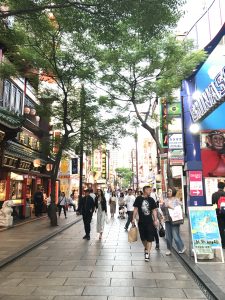
Outside of organized excursions, this week many of us finally accomplished laundry (somewhat successfully) and sang karaoke (definitely a success, at least for us). Jamming out via karaoke was a fun way to relax at the end of the week, and I sincerely hope that we have the chance to do it again. If there’s time during the mid-program meeting, perhaps we can even get the Japanese fellows to join! We also went to so many buffets this week—between Monday’s dinner in Yokohama’s China Town and the either gigantic or all-you-can-eat meals at Mt. Fuji, week two was definitely a Week of Overeating. While we weren’t jamming, eating, or recovering from food, we continued to explore Tokyo. My favorite place I went this week was Jimbocho. There were so many cool used book and music stores, and I found a Japanese version of Harry Potter with kana listed next to kanji! I hope to get through at least some of it this summer and use it to expand my vocabulary, reading skills, and learn more kanji.
Mt. Fuji Lakes Trip with Nakatani RIES 2018 Japanese Fellows
As we approached Mt. Fuji, heads slowly began to perk up (and some were woken up by the excitement) as we took in the view of the mountain top and the rich greenery surrounding its base. Before traveling to the fifth station, we made multiple stops and had the chance to see the Oshino Hakkai Ponds, a few shrines, and eat some delicious food. It was a lot of fun getting to learn about the history of each of the sites and hear stories about how they were named while also getting to know the Japanese fellows. Together, we found some cool trees, gambled on trying some unusual (but tasty) food, and met an incredibly talented and athletic monkey. I also had the chance to talk with Mariko and Shuhei about Osaka University, and am looking forward to seeing them there this summer.
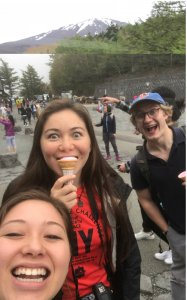
By the time the bus got to the fifth station of Mt. Fuji, we were already much more comfortable around each other. While we couldn’t see much below us due to cloud-coverage, every now and then we would get a clear glimpse of the mountain top and had the chance to take in an amazing view. After leaving the station, we checked into the Gotemba Kogen Resort and walked around until the Japanese fellows finished their first orientation seminar. We then ate far too much food at dinner and saw an awesome water-based light show. Like the physicists and engineers that we are, we spent a solid twenty minutes gushing over the control system and debating what we thought the mechanical structure was (it was a really cool light show). Afterwards, Mari, Mariko, Yui, Ellen, and I relaxed in our room and hit the onsen, after which we almost immediately fell asleep. It was a fun evening because we had so much time to just hang out with the other fellows.
We started Sunday visiting the a Numazu Deep Sea Aquarium. There were so many cool fish, and afterwards we walked around and explored the nearby fish markets before meeting up for lunch, where we grilled our own seafood! We then went to Mishima Skywalk, a 400 m long suspension bridge, from which we could admire Mt. Fuji and enjoy the outdoors. Afterwards, we went to a strawberry farm. Keeping with the theme of the weekend, we picked, and then promptly ate, an ungodly (I think Josh maxed out at 100?) quantity of strawberries before heading back to Tokyo and parting with the Japanese fellows as they traveled back to their home institutions.
Fuji was breathtaking, but my favorite parts of the trip were hanging out with the Japanese fellows. Between comparing American and Japanese university life, playing cards on the bus ride, and getting nervous on swaying suspension bridges, I had more fun than I ever could have expected to. All of the Japanese fellows are wonderful, and I was surprised by how easy it was to get to know them. They were as curious about life in America as we were about life in Japan, but we also swapped interests and stories in addition to experiences. It was really valuable to hear about what student life is like in Japan and how Japanese universities compare to those in the US. Additionally, it was interesting to compare the two cultures and find similarities and differences between them. I am incredibly thankful that we had the chance to meet the Japanese fellows, and I look forward to continue to get to know them throughout the summer.
Question of the Week
Are all of the fire hydrants in Japan underground?
- Yes, most fire hydrants in major cities in Japan are located underground. Though there are markers on the curb/sidewalk showing where they are located and you should not park too closely to the cover in case a fire truck needs to access.
- Did you know that you can also look down when walking streets in Japan to look for manhole covers? While in the U.S. these are usually just utilitarian, in Japan manhole covers often have cool designs related to the local area.
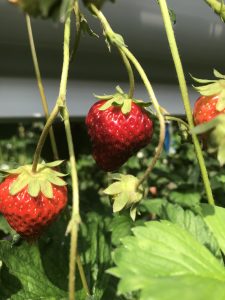
Intro to Science Seminar Overview
This week, we began our science and engineering seminars with a two-part talk from Kono-sensei of Rice University. He gave an overview on a lot of topics that we will be using in our research projects this summer, including devices and different types of material structures. His talks were very useful in reviewing material that I haven’t applied in a while and learning more about subjects that I am not very familiar with. I’ve been spending a lot of time on my own reviewing these topics so that I’ll have a better grasp of them when I start my research next week, so it was nice to have a more formal overview of the topics. Kono-sensei also encouraged us to reflect more on the materials we will be using during our research this summer. I will be working primarily with silicon dioxide to fabricate and analyze organic thin-film transistors this summer. Our transistors will be 2-dimensional semiconductors, and we will be studying its electronic and mechanical properties by measuring current and capacitance under strain. We will also use Transmission Electron Microscopy to analyze the structure of our transistors. These transistors are interesting to us because they can be bent at small radii without changing their electronic or mechanical properties. This allows for flexible electronics which can be applied to things such as biosensors and prosthetics.
We also learned about THz spectroscopy from Otsuji-sensei and carbon nanotubes from Saito-sensei from Tohoku University. My background lies primarily in optics and I love waves, so I was really excited to learn more about the THz spectrum. It has a lot of cool properties, and is particularly useful for characterizing materials because it occupies a middle-ground between the microwave and infrared spectrums. THz waves cannot currently be measured via electronics directly, so they have to be characterized by their wavelength and energy. It’s a really neat part of the electromagnetic spectrum, and I would love to learn more about it.
Saito-sensei’s lecture on carbon nanotubes was also a lot of fun. He started us out on an experiment where we cut ice with thermally conductive graphene and asked us to explain the magnetic fields it generates when it encounters solid aluminum. He then launched in to his talk where he explained the different structures of carbon nanotubes and how the orientation determines whether it is conducting or semiconducting. It was interesting to discover how the molecules are put together, and will be useful this summer when I apply what I learned about materials to the fabrication and analysis of our transistors.
Week 03: Noticing Similarities, Noticing Differences
At some point each day, we wind up in the subway station on a journey to some new destination in Tokyo. It’s very interesting to watch the culture of Tokyo’s subways; much like the rest of the city, during the day the trains are quiet and a respectful bubble of space is left for each person. While the personal bubble breaks down during rush hour for practical reasons, no one starts talking on the subway until late at night when young people and businessmen are traveling home from a night out.
This differs greatly from my experience on public transportation in the US. While the unspoken rule of not chatting with strangers is ubiquitous, it is broken in the US whereas in Japan a quiet “sumimasen” might be exchanged only if someone is blocking the exit. Additionally, at home in DC and on the busses in Williamsburg passengers are constantly talking to their companions. Phone calls on (above ground) public transportation in America are not uncommon, whereas In Japan there are reminders everywhere to keep your phone silenced.
Japanese passengers are also much more aware of the space they occupy. No one eats on the train, and everyone wears their backpack on their front to avoid “turtle-ing” and potentially hitting others around them or taking up more space than necessary. This reflects the tendency of Japanese people to generally be more aware of their surroundings and focused to maintain a respectful environment. While this behavior is practical, it is an immense component of Japanese culture in the attention to detail and mindfulness of each individual.
Orientation Program in Tokyo: Week Three Overview
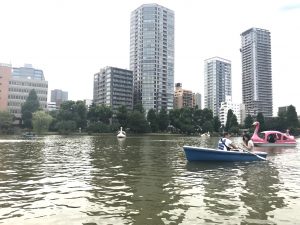
Museums are a lot of fun when they’re open, which is something we did not check when we tried to visit the Tokyo National Museum on Monday. However, that left us with a free afternoon in Ueno Park on a gorgeous afternoon. We stumbled through a showcase of bonsai trees in front of the museum and visited a few shrines. Behind one of the shrines was a huge pond. We rented a few swan shaped pedal boats and took to the water to enjoy the nice day. After we tired ourselves out, we walked to Kappabashi to check out some cooking kitchen equipment and strolled through Asakusa before calling it a successful day of exploring.
Because of a few schedule changes, we also had a free day on Wednesday during which we were able to go back to Ueno and visit the museum (while it was open). We hit four of the six buildings that make up the Tokyo National Museum and saw artefacts and art from throughout the Asian continent. I really enjoyed learning more about Japanese history and being able to compare Japan’s history with the history of countries such as China, Korea, Egypt, and India as we went through the museum. There was also an exhibit on different types of burial mounds, and it was cool to learn more about burial mounds in the region after we discussed them with Sasaki-sensei. I’m glad we had the chance to go back and explore the museum, and I hope to have the opportunity to see the rest of the exhibits sometime in the future.
We also learned a lot about Japanese history and culture from seminars we had this week. Ito-sensei led an incredibly informative and interesting discussion on the history of the kimono. I never really understood the connection of the kimono to nature and how it can bridge generations given how long they last. I also never considered the sustainability of kimonos. While it takes a long time to make a kimono, the end product can go up to a year without washing and last for at least a hundred years. Thus it can be passed down and worn by many people. After the kimono finally cannot be worn as clothing, it can be transformed into blankets, cloths, and ultimately turned to ash and used as fertilizer since it is made of entirely organic, plant-based material. Ito-sensei is working on a really cool project to design kimonos for the Tokyo Olympics in 2020, and I’m excited to see the final product during the games. I’m also curious to see if this will spark the revival and spread of the kimono that Ito-sensei seeks to facilitate.
I really enjoyed learning about rituals associated with the kimono, such as the tradition of the Miki family growing the materials to make the emperor’s kimono and praying for the previous emperors to join his spirit. It connects the present to the past and fosters a spiritual connection in Japanese leadership. We also discussed Japanese tea ceremonies and their origin in samurai culture, learning the reasons for its meticulous nature. A small error could end a samurai’s life, and thus a mistake in the tea ceremony can have detrimental implications. Additionally, each individual involved in the tea ceremony is considered an equal and all must bow deeply to enter the room. The careful process of the ceremony and the instruments of maintaining equality and respect are demonstrative of Japanese culture in the attention to detail and harmony. We also learned that the most important rule of the Japanese tea ceremony is to “just make a tea” which I found really powerful in that ultimately its most important to accomplish the task at hand and not get distracted by mistakes or stressors.
Outside of Japanese history and culture, Nishikawa-sensei discussed the history of life-sciences with us. He gave a very interesting overview of the development of science into the present. I enjoyed hearing his perspective on when modern science emerged and how the transition of thinkers to trying to describe phenomena, rather than all aspects of life, led to science as we know it today. We also discussed the development of different types of communication and data acquisition. There are many different ways that we store and share information in individual interactions and scientific endeavors, and I’m excited to see how these systems develop over time.
Moving into the present, Ozaki-sensei came to talk to us on Friday night to give us a final crash course on Japanese culture before we all parted ways to start working in our labs. She overviewed the giving of omiyage, or souvenirs, to our labs and people we meet, how to bargain in Osaka, and different types of Japanese verbal and non-verbal communication. I am very thankful that we have had Ozaki-sensei as a resource here. She is incredibly helpful and willing to share stories, answer any questions we have, and laugh at the experiences we and her students at Rice in Japan have while bearing reminders to laugh and learn at the (many) mistakes we have made and will continue to make throughout the summer and the rest of our lives.
Ozaki-sensei also reviewed some vocabulary with us and quizzed us in the wake of our final Japanese class and concluding speech. Throughout our three weeks in Tokyo while taking language classes, we have learned so much, and it’s been a really fun experience. Between conjugating verbs, cementing particles and sentence structure, and just trying to grow my vocabulary, I feel myself slowly understanding more and more Japanese. While I still have a very (very) long way to go, I get excited each time I can understand an announcement or hold any amount of a conversation in Japanese. I hope to continue to develop my language skills in Osaka and to speak Japanese as much as possible to maintain and grow my Japanese lexicon.
Before boarding the Shinkansen on Sunday, we had a free day Saturday. Ellen, Grace, and I rented bikes and rolled over to Odaiba to explore the artificial island, visit a science museum, and locate sand and water. It was so nice to bike around Tokyo rather than taking the subway. While the city is very convenient, we all missed spending time outdoors after a week of language classes and lectures. Odaiba is an island that was built to towards the end of the Edo period to prevent against attacks at sea, so the only way to get to it is across the beautiful, 800 m long Rainbow Bridge. At night we were treated to the breath-taking sight of the sun setting behind the Tokyo mainland.
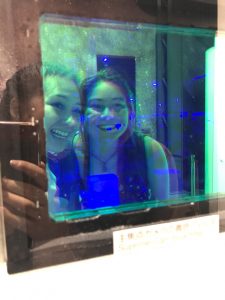
Odiaba itself was wonderful, and after a short hiccup where we had to figure out how to lock and unlock our bikes, we rolled along the perimeter of the island to the Miraikan, a museum of modern science. It quickly became my favorite museum of all time with its interactive, interesting displays and focus on what is currently being studied and where our society is headed. I loved the exhibits on the Subaru telescope and Super-Kamiokande, a neutrino research facility. There were also many thought-provoking displays on sustainability, renewable energy, and natural disasters. We learned about research into developing a plastic that can be grown in rice plants, different types of alternative energy, and how humans can negatively or positively impact the environment and ecosystem.
After we left the museum, we ate lunch on a pier, biked around, and settled on the beach to watch the sunset. It was incredibly relaxing to be on the water and we all felt very refreshed and eager to start working in the wake of our day learning, exploring, and beaching. After biking back to the Sanuki Club, we spent our last night with the other fellows planning group excursions and discussing our excitement and nervousness to start at our labs.
Intro to Science Seminars
We had some interesting science seminars this week. Professor Stanton discussed electronic structures, electro-optical properties, and femtoseconds laser spectroscopy with us. I really enjoyed learning about the different ways that femtosecond pulses and the terahertz spectrum can be used for imaging as an alternative to x-rays and how different electronic structures are utilized in things like solar cells

Futaba-sensei discussed the fabrication of carbon nanotubes and working in Japan as a Japanese-American immigrant with us. I enjoyed learning about how his lab grew carbon nanotubes and how they realized the success of the process they currently use. It was interesting to hear how their method differed from other types of nanotube growth and how each method yielded different types of nanotubes. I also enjoyed Futaba-sensei’s stories about “serendipity in science” and the reminder to remain flexible and curious because breakthroughs can come from anywhere.
We also heard from Ishioka-sensei about ultrafast spectroscopy and what it is like to be a female scientist in Japan. Her lab is doing really interesting research with femtosecond pulses, and I loved hearing about the different uses of femtosecond lasers ranging from spectroscopy to cleaner optical drilling. She also had a really thought-provoking perspective on being a female student, and ultimately researcher, in Japan. After her lecture, we discussed the impact of role models and opportunity on whether or not someone pursues a career. Ishioka-sensei had a lot of strong role models and a good support system that encouraged her to pursue physics, which she was really passionate about. However, in many cultures, including in Japan, these do not always exist for women. Ishioka-sensei talked about how there aren’t many female teachers in higher education and women aren’t necessarily encouraged to go into sciences, pondering whether or not this has an effect on women entering the field overall.
I am incredibly excited to begin my research. As we get closer to starting in lab, I’m interested in learning as much as possible about different printing techniques and understanding the impact of different structures on the performance of the material. I have been reading papers given to me by Uemura-sensei and on related topics and am excited to start working and apply what I have learned while gaining a better understanding of the research.
As I prepare to start in my lab on Monday, I have been reflecting on the past few weeks in Japan and all that we have learned in our short time here. I know nine weeks will fly by, but I hope to learn lots and make good contributions to my lab while I am here. I’m excited to apply everything we’ve studied and learn from my experiences. I look forward to making and learning from my mistakes (starting from the first one where Lincoln and I hopped on the wrong JR train) and enjoying each setback, success, and discovery.
Question of the Week
There are many types of ways to sort waste in Japan, but I’ve never seen any bins for compostable waste. Is there much composting in Japan, or is most waste burned or recycled?
- For more on this, see the Trash and Recycling in Japan section on our Life in Japan resources page.
Week 04: First Week at Research Lab
Sunday morning we all said goodbye to the Sanuki Club, bid farewell to the other fellows, and the Kansai (+Nagoya) Crew headed to Tokyo station. The Shinkansen ride was spent sharing nerves, excitement, tentative plans for the summer, and working on our weekly reports. Our numbers slowly dwindled until Lincoln and I were the only ones left to get off at Shin-Osaka station. Since neither of us could check into our dorms until Monday, we headed to our hotel (only getting on the wrong train once and going to the wrong tracks twice!) and walked around the area before turning in to prepare for our first day in lab.
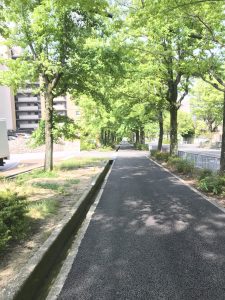
We managed to get to Suita campus unscathed and were greeted by Kurahashi-san from my lab and TJ-san from Lincoln’s lab. Lincoln and I said our goodbyes, and Kurahashi-san led me to the Institute for Scientific and Industrial Research where I met me new colleagues. Everyone in the lab was very welcoming, helpful, and kind. I started to get to know a few of my lab-mates over lunch, and then one of the lab secretaries helped me fill out paperwork before I checked into my housing. Monday afternoon I met with my lab mentor, Umeura-sensei, to start learning more about organic thin film transistors and my research.
The rest of my work week was spent studying “Organic Field Effect Transistors” and “Organic Electronics II” while learning as much about transistors as possible. Umeura-sensei is very helpful and I met with him daily to go over different transistor characteristics, applications, and fabrication methods. While I read a lot of papers before coming to Osaka, I’ve been gaining a much better understanding of the topic in the week that I’ve been here—it definitely helps that I have someone to ask questions about anything that I don’t completely understand and explain the advantages and disadvantages of different structures and fabrication techniques.
Outside of studying, I’ve been getting to know the people in my lab. Everyone is incredibly focused and very friendly. The graduate students in my lab are amazing, and they’ve helped me start to figure out how to navigate the campus, made sure that I know all of the different places to eat, and have given me tons of suggestions for things to do and see—we even have plans to go exploring in the city next weekend! It’s super fun hanging out with them and getting to know other students on the campus. While my lab is mostly Japanese, everyone speaks very good English. I try (and sometimes fail) to speak Japanese with them as much as possible, although some are eager to have the opportunity to practice their English with a native speaker. Still, I wish my Japanese was better so that others wouldn’t have to switch languages so much.
There are three other international researchers in my lab—one visiting German PhD student and two Austrian postdoctoral researchers. They immediately welcomed me into their cohort and showed me where to find all of the supermarkets, hyaku yen stores, and different parks in the area. They also shared fun (and familiar) stories about navigating things like laundry and cooking (my apartment has a hot plate that I fight with daily). Kurahashi-san has also been a great resource—he checks in on me regularly to make sure that I’m getting settled into the lab and it’s fun to hear his stories about his family and experiences.
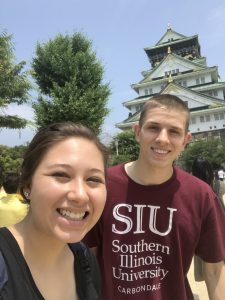
When I’m not in lab, I’ve been exploring the campus and surrounding areas. I live in housing designated for visitors to the research complex I work in, so I have a super easy walk to and from lab. There are some cool parks in the area and a lot of different supermarkets, stores, and restaurants. At the end of the week Lincoln stuck around Suita campus so we could make dinner and plans to explore the downtown area on Saturday. We checked out Osaka Castle, the aquarium, and walked around. It was really fun learning about the castle’s history. There was also a triathlon going on around it, and it was cool seeing the competitors and the huge crowd cheering them on. The aquarium was incredible. There were so many different species of fish and other animals that inhabit the Pacific’s Ring of Fire. Afterwards we rode the Tempozan Ferris Wheel, one of the largest Ferris Wheels in the world, and got to see all of Osaka from the top—it was incredible! Afterwards we grabbed food at Dotonbori, a huge food street in Osaka. It was delicious, and I need to go back!
Sunday I explored some more of the areas around campus and found rain boots in preparation for Osaka’s rainy season. I’m so excited to continue to discover everything in Osaka and the surrounding areas during my remaining time in Japan. I love working in my lab and I can’t wait to start my project and continue to get to know everyone here. I’m learning so much, and I already know it’s going to be incredibly hard to leave when I have to go back home in a few months.
Reflections on the Orientation Program in Tokyo
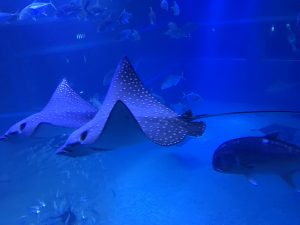
One of the weirdest parts of this week was not being with the other fellows—while we only met last month, we spent so much time together learning about Japan and Japanese culture, it was almost strange to be exploring without everyone else around. I am so thankful for our orientation experience because it made the experience of coming to a new lab in a different country much less stressful than I imagine it would be otherwise. Language classes chipped away at the communication barrier, and having time to learn about Japan made it much easier to assimilate into the lab and culture. Our science seminars have already proven to be very helpful, and the different aspects of Japanese history and culture we learned about were super interesting.
I also learned a lot about myself during the orientation period. I am not great at planning: however, there are a lot of fun experiences to be had when you’re free to just explore what’s around you. I’ve also gotten much better about looking for things to do in advance rather than just in the moment. I am not navigationally gifted: but, google-sensei is a gift and the Japanese public transportation system is a godsend. (Also, the people in Japan are incredibly helpful and kind.) I’ve also realized that I really enjoy learning about history—I had so much fun in our lectures and have found so many cool museums. I’m excited to continue to explore Japanese history and culture, get lost, and discover amazing new things about Japan.
Research Project Introduction
This summer, I will be designing and fabricating a wearable heart monitor. We hope to create a thin and light sensor to track the wearer’s pulse and deliver a readout via a Bluetooth signal. This will be accomplished by utilizing an electrode to track changes in pressure with each heartbeat and a transistor amplification array so that it’s easier to identify and characterize the signal. We hope to integrate the design into something that can be worn on someone’s wrist to easily and comfortably monitor biosignals.
Currently, I am working on designing the pressure sensor and thinking of different ways to attach it. We want to minimize the signal to noise ratio in our electrode so that we have the most accurate reading possible. Our signal is larger than we expected, but it’s sometimes difficult to get a reading; we have to apply a lot of pressure in order to get an identifiable singnal, and the positioning of the sensor needs to be very precise. Thus, I’m trying to figure out how to have the greatest amplification of signal while securing the sensor without making it uncomfortable for the wearer.
Next week, we are going to begin fabricating the first design of our electrode. I’m excited to get clean room training and begin testing and analyzing our sensor. I know that the process of design, test, analyze, and redesign will be a tedious one, but I can’t wait to see what we find as we try to refine our sensors. I have been doing a lot of research on methods for tracking pulse and the best ways to measure it, and will use this in conjunction with experimental data to try to refine the sensor design.
After we optimize our sensor design, we will begin fabricating our amplification transistor array. The graduate students I’m working with have already warned me that it will be very difficult to fabricate, but I’m excited to learn how to print the transistor array and enjoy the process of fabricating and optimizing the array. I don’t have any experience yet with fabrication, so I’m really interested in learning the process and applying it. I know that I’m going to learn a lot this summer and can’t wait to make mistakes, learn from them, and hopefully create a functional product.
Ultimately, we want to be able to have a demonstrable heart rate sensor by the end of the summer. This will integrate our pressure sensor, amplification array, chip, and battery. I know that I will go through many iterations of the different components and final design and need to be flexible as we try to use a new material to characterize heart rate. However, hopefully by the end of the summer we will have an inexpensive, thin, and lightweight product that will make it easier to track heart rate.
Question of the Week
Most labs in the US have a lot of foreign researchers—is it the same in Japan, or are most labs predominantly Japanese
- According to the 2018 NSF S&E Indicators Report, “Since 2008, enrollment of international students in S&E fields has been rising, while graduate enrollment of U.S. citizens and permanent residents has declined overall. In 2015, international students accounted for 36% of S&E graduate students, compared with 26% in 2008.” This is equivalent to 367,920 international graduate students in science & engineering alone in the U.S.
- This is compared to Japan where, according to MEXT, in the annual survey of international students in Japan in 2014 (the most recent data available) there were overall “184,155 international students in Japan (up 16,010 (10%) compared with the previous fiscal year).” So, in Japan, the total number of international students in all fields overall is far less than the total number of just international graduate students in S&E in the U.S.
- This is why, in Japan, there may be a few international students in each research group but usually there are more Japanese students than international students. In the U.S. the opposite can be true, there may only be a few American students and most of the other graduate student members of the group are international.
Week 05: Cultural Analysis – Life in Japan
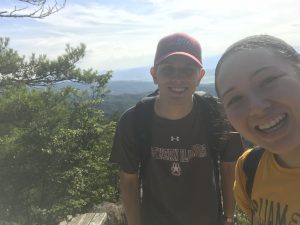
I have yet to encounter any major “cultural conflicts” yet in Japan, although there are plenty of instances where my subpar Japanese has led to some interesting moments. Just this past week, I had a colleague who was very amused when I wasn’t sure if the kanji on one of the machines meant I could use it or not, and I had a lengthy conversation with a few friendly women on the train about two very different things titled “Stand By Me.” (The song by Oasis is definitely not American, unlike the movie.) However, this confusion is usually eventually (mostly) sorted out, and the encounters are harmless, albeit sometimes embarrassing.
Something that I’ve noticed a lot while talking to Japanese people, however, is the different meaning of the question “Where are you (or where is your family) from.” This is something that gave me pause when we were filling out forms to enter Japan, and I have slowly started to have a quicker response to. I’ve spent years filling out forms where under “nationality” or “ethnicity” I’m expected to bubble in “Japanese” and “White,” or “multiracial.” In Japan, however, I am just “American.” No one really cares about where my great-grandparents are from unless it’s to hear about why I have family that lives near Osaka or why my parents named me “Hana.”
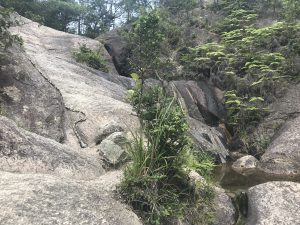
It’s definitely caused me to reflect a lot on the focus of race in American culture and how the issue crops up differently in different places. I know that there is a problem with racism in Japan, particularly towards Korean and Chinese residents, and things like blackface still appear in media. However, it doesn’t seem like the issue is talked about as much (although I might be reading the wrong news sites to hear about it). There is some precedent in court protecting non-Japanese people, but there are no laws protecting them from discrimination or prohibiting hate speech. Perhaps Japan is much more homogenous than America, so fewer people experience negative stereotypes and overt efforts on a daily basis. Perhaps, because Japan is more homogenous, it’s easier to identify the “other.” It makes me wonder a lot about how each country treats the issue, and the best way to approach this issue of racism.
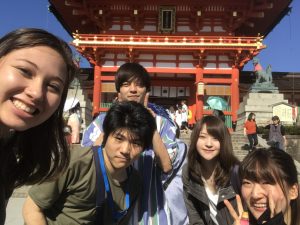
Outside of lab, I have continued to explore the Kansai region and get to know the people in my lab. On Thursday, I was invited to dinner with Kurahashi-san and his family. It was a lot of fun—his wife and daughter are wonderful, and I am very thankful that I had the opportunity to meet them. It was fun to hear about all of the places they’ve been, get to see pictures of Kurahashi-san’s son and granddaughter, and learn new Japanese phrases. The food was also delicious! This past weekend, I went to Kyoto with a few of the students from my lab. They’re all incredible people, and I am very lucky to have the chance to get to know them. They took me to a bunch of “Kyoto-ish” places and introduced me to a lot of delicious food. I made a lot of really great memories. Our next stop is Kobe, and I can’t wait to go! Sunday, I went hiking in the Konze Alps with Lincoln-san, and we had a really great time getting lost, orienting ourselves, and getting lost again. We saw some gorgeous views, beautiful waterfalls, and really cool rocks. It definitely made me even more excited to hike Fuji-san with the other fellows in August!
Research Project Update
This past week was spent continuing to work on my research project. I attached leads to my sensor so that I could test and eventually add components to it. The primary thing we were concerned about was having a high enough signal to noise ratio. Our SNR is currently high enough that we can amplify it with our transistor array, but we encountered an unexpected issue with the electrical connection between the leads and the sensor.
The leads are secured with epoxy, and the electrical connection is created using silver paste to form a connection between the wires and the electrode printed on our pressure sensitive sheet. However, since the silver paste is not very strong and our sensor is very thin, I have encountered a few issues with the sensor bending that might be compromising the connection between the leads and the electrodes. In order to facilitate measurements, I’ve tried to tape the leads together so that they cannot move such that they pull the sensor apart, since they are on opposite sides of the sheet. While this helped, the connection was still eventually broken. When I try to collect data again next week, I plan to secure the sensor to my skin before measuring my pulse so that it’s less likely that the sensor will move and break when I try to take data on the oscilloscope. Looking forward to the final product of my project, I have designed a sensor that has the same dimensions, but will wrap around the wrist instead of being directed down the arm. This will hopefully make it more difficult to damage the connection between the leads and the sensor and facilitate more electrical connections while being more practical for wearable applications.
Since I broke the first sensor, reconnected it, and broke it again, I also fabricated a new set of sensors this past week. My second time fabricating the sensor’s electrode went much better than the first, so I have a thicker layer of aluminum that will hopefully also protect the sensor beneath it so it will be stronger. I was able to attach the leads before the weekend, so I hope giving the silver paste more time to cure will also help with the stability of the device. Next week, I’ll take more SNR measurements and start fabricating the transistor amplifier circuit so that our signal is more identifiable and usable.
Question of the Week
Are there many efforts to gain legal protection for non-Japanese individuals experiencing racism or discrimination?
- For an overview of the rights of foreigners in Japan, see the Ministry of Foreign Affairs (MOFA) website at There are also Human Rights Counseling Offices for Foreigners in Japan. For an external view of the human rights landscape in Japan, see the Human Rights Watch report on Japan.
- Some recent media articles on issues related to rights of foreigners in Japan, particularly permanent residents and hafu in Japan include:
- Japanese Student Sues Over School’s Order to Dye Hair Black (Guardian)
- Welfare Ruling Stuns Foreigners (Japan Times)
- Think You’ve Got Rights as a Foreigner in Japan? Well, It’s Complicated (Japan Times)
- Japan’s Foreign Residents Offer up Insights on Unprecedented Survey on Discrimination (Japan Times)
- 40% of respondents reported discrimination in housing, yet it is important to acknowledge the U.S. has a historical legacy of legal (de jure) housing discrimination and today de facto (in fact) housing discrimination against minority groups and by socioeconomic class (e.g. ‘Section 8 not accepted’ stipulations that you often see in Craiglist ads). For more on this, see the section on De Jure vs. De Facto discrimination on our Life in the U.S. resources page.
- Some other resources on this topic that may be interesting to review include:
- Book: Japan and Global Migration: Foreign Workers and the Advent of a Multicultural Society (UH Press)
- Changing Face of NGOs in Japan
- NGOs and Volunteers Working for a Multicultural Japan
- Asian Migrant Centre
- NGO Pushes for Foreigners Rights (Japan Times)
- 4 Women’s Right’s Organizations You can Support in Japan (Gaijin Pot)
Week 06: Cultural Analysis – In the Lab
“How is it going?” A harmless question asked by one of my labmates that I have answered countless times. And yet, when I responded with the customary, “good,” they react with shock and disbelief. Research is always facing challenges, and they just watched me break (and reattach) my leads for the third time. I realized what they wanted to hear wasn’t the customary American reaction of “Everything is good, it will all be fine even if it is definitely not fine” but an honest reply of “it’s a bit hard but I hope that this time I get it!”
American and Japanese small talk is definitely different. American small talk is frequently carried out at much greater length than Japanese small talk, but Japanese small talk seems to carry more meaning: it isn’t just exchanging pleasantries, but a genuine effort to check in and commiserate over shared challenges.
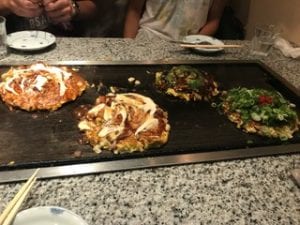
I’ve learned to be more genuine when responding to questions that feel obligatory back home. It has caused me to reflect a lot on American pleasantries. It’s unusual how we ask so many questions that we don’t seem to care to know the answer to, or answer not expecting the other person to actually care. While I hope that I am always an active conversationalist and express real interest in whatever the person I am talking to is saying, I definitely expect to pay more attention and be more aware once I go back home to the US.
This week has definitely been a crazy one. Monday morning I was shaken awake as things fell off tables and tectonic plates shifted. In the daze of someone just woken up by an earthquake, my sleepy self somehow remembered our safety training back in Tokyo and dove for my desk, where I hung out for the next half hour waiting out the immediate aftershocks. I made it into work a whole ten minutes later than usual, where I helped clean up until I was told to leave and wait out the biggest aftershocks in the safety of my apartment. Probably should have seen that one coming. Luckily, everyone was safe and our lab didn’t sustain too much damage, although we did have a few chemical spills and machines break. The week contained many tense moments of emergency alerts going off followed by a large sigh of relief when we read that there was just a bad weather warning (Osaka couldn’t seem to catch a break).
Earthquakes aside, I feel that I am feeling much more comfortable and stable living alone in Osaka. My navigational skills have definitely improved (probably my proudest accomplishment) and I’m able to go from place to place without too much reliance on google maps or maps.me. I’ve gotten much better at identifying landmarks, reading street signs, and walking fewer steps in the wrong direction before I realize my mistake. While I absolutely still get lost and sometimes hop on the wrong train, the instances are fewer than they were when I first got here and usually don’t last for quite as long.
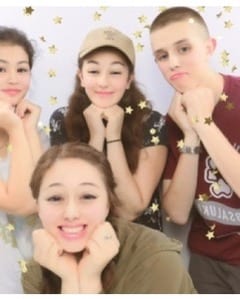
Everyone that I’ve met here is so incredible. I’ve made some great friends in my time this week, including a few this week. (and had the opportunity to reunite with some old ones!) Umeura-sensei introduced me to one of Sekitani-sensei’s students who is interested in studying or researching abroad. It was nice talking to her, and we plan to get together again more casually. It was also interesting to learn more about student and academic life in Japan and hear about the Japanese Fellows’ experience from Mariko so she could share her perspective of the Nakatani Fellowship and study abroad with Sekitani-sensei’s students.
Over the weekend, Kaitlin, one of the US Fellows, came down from Tokyo and, like a true Florida native, insisted we go to Universal, Japan. It was so much fun! There was so much good food, cool music, and fun rides. My favorite was a final-fantasy one where you ride a roller-coaster while wearing an oculus rift headset. We were transported into a videogame, and I’m eager to see how they revamp the ride every year through the Universal Cool Japan initiative.
Sunday, we ventured into downtown Osaka and met up with Emily Nishiwaki, one of the 2017 Nakatani Fellows. After walking around the Osaka Castle for a while, I got my return trip to Dontonbori. Even better, we found gluten-free okonomiyaki at Mizuno, and it definitely lives up to the hype. I could eat those pancakes forever. Now all I need to do is find gluten-free takoyaki! (Although that one I might just need to figure out how to make myself.) It was super fun having another chill afternoon exploring Osaka and hanging out with other fellows (old and new).
One of the things I have been struggling with recently has been how fast time is moving. As the weeks fly by, I watch my calendar slowly get closer to August 7th, the day we unfortunately must make our departure from Japan. I want to see and do everything; but, I don’t want my time here to be spent crossing items of a list without really getting to know and appreciate them. I’ve slowly come to realize (with the help of the other fellows) that it’s okay if I don’t make it to every destination I had in mind before I got here. I’d much rather get to know the Kansai region and surrounding areas (and the people in them), and hopefully come back again to explore the areas that are more difficult to make a weekend trip to. Japan is wonderful and large, and it’s easy to find exciting things wherever you go. I’m so glad that I have the opportunity to explore Japan while I’m not exploring flexible electronics.
Research Project Update
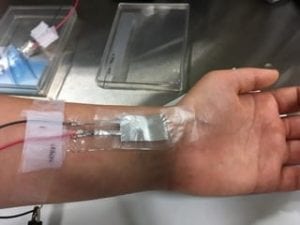
Speaking of flexible electronics, my project seems to be moving forward. Because one of our vacuum chambers broke during the earthquake, we were set back a week on fabricating the pseudo-CMOS amplification array. However, this gave me time to read more about the theory behind the transistor array and do some extra data taking and analysis, so it was definitely not a loss.
I was able to finish taking pressure signal data on our sensors (the tape method worked!) and do a FFT analysis to look at the frequency composition. While my computer fights me every time I try to run my massive spreadsheet, I have emerged victorious in identifying the signal and noise frequencies. We have a high low frequency signal and low electronic noise at 60 Hz, so our sensor should be good to go for our amplification array.
Since we weren’t able to fabricate the Pseudo-CMOS array this week, I also took some time to see how our signal was affected if the area of the sensor is reduced. It looks like we can half the area without increasing the noise. This means that we can fabricate more sensors at a time since each mask will be smaller. Additionally, the smaller size will make them less expensive, easier to secure, and more comfortable for the wearer.
Question of the Week
When I was talking to Sekitani-sensei’s student, she mentioned that she was a candidate to join Sekitani-sensei’s lab. This might be a question for the Japanese fellows, but is it difficult to join a research lab in Japan?
- Remember how we said that only B4 students do research in Japan. But what is different about the U.S. system is that *all* B4 students in science & engineering do research. This means that, sometime in their B3 year, they will begin to do short visits/tours of different labs and maybe do interviews with their top choices. The professors then choose which students they want to have join their group in their B4 year and mentor/advise for their senior thesis.
- Then, if they decide to go to master’s, students in Japan will take an entrance exam (pretty much the only thing that matters when applying to graduate school in Japan) and if they pass that exam they will often stay in the same lab for their M1 and M2 years.
- Some schools do the B4 lab assignments differently, by exam or students with a high GPA getting priority placement for example, but a candidate for a lab means that they are applying to see if Sekitani-sensei to accept them as a B4 student next year.
- Talk more with the Japanese Fellows about how this works for each of them but for most of the 2018 JP Fellows, their research experience at Rice will be the very first time they will do hands on research as they’ll do this before their B4 year.
Week 07-08: Overview of Mid-Program Meeting & Research Host Lab Visit
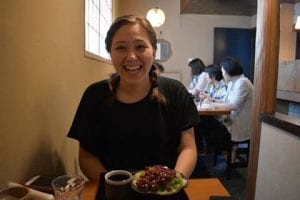
Saturday morning I found myself at Arashiyama watching some lively monkeys play tag and swim in a pond. As I strolled down the mountain they inhabit, I ran into Grace, and my reunion with the Nakatani Fellows had officially begun a few hours earlier than expected! Before meeting our friends, we explored some more of Arashiyama, ate our way through Nishiki Market, and discovered a restaurant with vegan milkshakes and gluten free desserts. Dinner with the US and Japanese fellows was so much fun, and I’m so thankful that we had the chance to see everyone again and catch up.
While Saturday night was one of catching up, making plans, overruling them, and singing our hearts out during karaoke, Sunday was one of reflection and looking forward. Kono-sensei and Sarah-san led a discussion with the US Fellows about our experiences so far, asking us to reflect on the good, the bad, and the interesting. It was really valuable to learn about everyone’s experiences and how they overcame their various challenges. Many of our struggles where shared, and it was nice to be reminded that everyone has trouble with something sometimes, and more often than not that trouble is not an isolated case. Additionally, it was nice to get feedback on different ways to approach my own struggles moving forward in lab and exciting to hear about what everyone was looking forward to in the last few weeks of the program. That evening, we reflected on Japanese culture as we all donned yukata and participated in a Japanese Tea ceremony. I loved learning about the meaning behind each part of the ceremony. It carries great significance in its philosophy towards hospitality, and is something that I hope to practice in my everyday life.
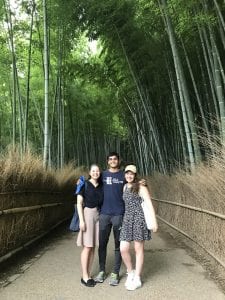
The halfway point to our meeting came quickly, and Monday morning we all stood at the front of a room giving five minute presentations on our research. It was so cool hearing about what everyone is working on—I am so lucky to be among so many brilliant people and have the opportunity to learn from them. I can’t wait to hear what everyone’s results are! Monday afternoon we got the chance to see a bunch of labs in Kyoto, and it was amazing to hear about what they’re working on and see all of their equipment.
The end of our time in Kyoto provided us with an opportunity to see many things that most tourists don’t have the opportunity to at Kamigamo Shrine and Shoukoku-ji Temple. Learning about the different prayers and history of Kamigamo shrine was incredibly interesting, and the history of Shoukoku-ji Temple and the purpose of all of its architectural elements was fascinating. The following day, we also had the opportunity to tour Sysemex, which was incredible. Their research is so interesting, and their facility is beautiful. I am thankful that we had the opportunity to learn more about it.
The mid-program meeting held some of my favorite moments so far in Japan, from walking 20 miles one night and relaxing in the middle of the Kamo river, it was nice being surrounded by the US Fellows again, providing a reprieve that I didn’t realize I needed. I learned so much from the seminars, presentations, and excursions, but even more from the other fellows and my own experiences and mistakes (such as to never sacrifice running shoes for rainboots, because you’ll end up walking 20 miles in flats, as much as you miss your friends sleep is really valuable, and never to buy a rice cooker while exhausted because you’ll end up getting the wrong one, not being able to return it, and having to spend an hour in Yodabashi camera in tears until you finally figure out which transformer won’t cause fires. (The last one worked out but led to a very stressful Saturday).
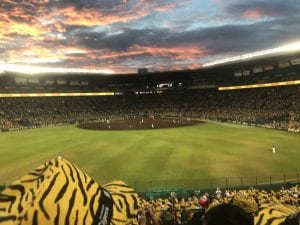
In the next few weeks, I’m looking forward to continuing to work on my research, exploring Japan, and meeting up with US and Japanese Fellows alike. While flexibility for one reunion had to be exercised this weekend due to heavy rain in the Kansai Region (I’ll get to Nara eventually!) I definitely learned the value of having a day to wander around aimlessly and had a much needed day to breathe among the chaos that was my rice cooker fiasco. Sunday was much less bleak, and held an exciting day of continuing to explore Osaka, this time in the company of Gavin. We found new streets housing endless stalls of food, lots of cookware, and a shrine shaped in the head of a dragon where a few people were practicing for an upcoming festival. We ended the day at the Hanshin Koshien Stadium, partaking in the cheers and chants in support for the Hanshin Tigers. While this past weekend held a lot of stress, it served as a reminder that rough patches will occur, but will also pass, which is something I will keep in mind throughout the rest of the summer and after we leave Japan.
Research Project Update
On Monday, Sarah-san and Ogawa-san came to visit my lab. It was exciting to share my research and experiences with them, and talk about my project moving forward. As far as research goes, so far the transistor and inverter arrays on our device work! (At least, on one device—not all of the inverter arrays worked on the other, but I expected something to be wrong because I scratched the dielectric layer during fabrication). On the damaged device, it seems that via holes were not drilled into our capacitor, leaving us with a dielectric sandwiched between two electrodes with no way to charge it. We tried to drill silver paste to connect the two layers, but were unable to measure any capacitance. We’re still trying to determine how to take this measurement, but until then have characterized our working device. Next week, we will hopefully determine the capacitance of our damaged device and will test the pseudo-CMOS arrays. Hopefully they work on both devices!
After we test our Pseudo-CMOS array, we will be attaching our sensor to the amplification array and microcontroller. We’re trying to determine the best way to do this, and will likely do more testing on our sensor to see if we need to mount resistors and capacitors to our array or if we can attach it directly to our microcontroller.
Question of the Week
Each player on the Tigers’ team had a sperate chant: how do the fans come up with them, and how does everyone learn them? How to traditions emerge in general? Is it superstition, because it’s “what’s always been done,” or something else entirely?
- For more on Hanshin Tigers and other baseball traditions in Japan, see the Baseball section under Sports in Japan on the Life in Japan resources page.
Week 09: Research in Japan vs. Research in the U.S.
I’ve been fortunate to have had the opportunity to work in a few labs in the past two years, ranging in size, focus, and age distribution. All have been filled with passionate scientists who work 9-10 hours a day on their research (although sometimes more), have strong senses of collaboration, and a desire to make some difference in the scientific and broader community. I think these things are probably fairly universal in research, since they are instrumental in its success. Regardless of where I go, I would be surprised if I was unable to find these characteristics.
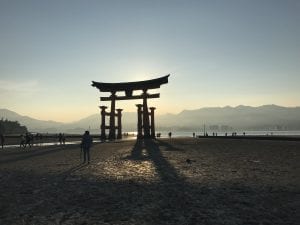
However, I have noticed some differences between my lab in Japan and those I’ve worked in in the US. While there is a strong sense of collaboration, everyone belongs to a subgroup of the lab: materials, process, or integration. It doesn’t seem like people move between these too frequently, whereas in my experience in the US, researchers might be separated somewhat by theory vs. experiment, but frequently change or add disciplines. However, this could also result from working in a research institute within a lab that contains many full time researchers and industry members.
There’s also a much more distinct separation between the different levels of students, researchers, and professors. Everyone is more or less grouped with others of the same age or social status, and referred to with their honorific. On one of my first few days, my mentor told me I could call him by his first name, since he knew that’s what is more common in the US, but I felt uncomfortable since it would contradict so distinctly with the environment of the lab. It does seem that some exceptions are made for foreigners, as a visiting PhD student referred to everyone by their first names, but given that I am the youngest in the lab (and in general didn’t want to brush up against its culture) I try to avoid playing the “gaijin card” as much as possible.
One other large difference I’ve noticed is how people go about starting their lab work. My graduate student mentor always asks me if “I am OK to start research now” or to work on something if I am not too busy, rather than saying when he would like to start or asking if I can work on something. It’s made me more aware of my “individuality,” and how it can contradict my labs culture or cause difficulty for those around me. I want to be working on my project all the time, but I frequently have to be supervised so I don’t break expensive equipment or need someone to help me take data while I’m keeping our sensor in place on my wrist. I have to be conscious of sharing that equipment with 35 other lab members, all of whom have their own experiments and projects.
It has caused me to become much more conscious of others’ schedules and workloads. Whenever my mentors ask me if I would like to take a break, I’m always tempted to say that I’m ok to keep working and push through to make sure that we collect all of the data we need before our equipment reservation is up. However, often this question might be asked because others need a break, or have something else they need to work on. I’m a small component in the huge machine of the lab, and it’s important to remember that we’re all working towards a common goal, and that each person plays a different part within the network. We sometimes overlap, and we all need to collaborate and have the opportunity to work hard so that the whole system can succeed.
Life in Japan
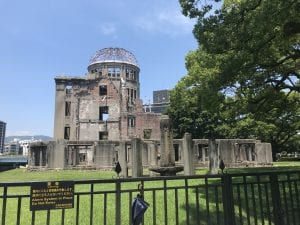
This weekend, I met Gavin and Grace in Hiroshima. After some confusion with trains, we all converged at Nakataya, a restaurant that serves Hiroshima-style okonomiyaki (with gluten-free and vegan options!). After lunch, we explored the Peace Park. While the Peace Memorial Museum was closed for renovations, there were many powerful monuments in the park. They serve as an important reminder of the tragedy of the nuclear bombings and the long recovery Japan underwent after them. There were a few exhibits in the park consisting of news articles preceding and following the bombing, and it was really interesting to read about the war from the prospective of the Japanese media. American students are usually exposed to a lot of American and Western ideas regarding historical events, and the education ignores important realities far too frequently. While I learned a lot about how Japanese-Americans felt about the war from my family while growing up, I have not had as much exposure to the perspectives of Japanese people. The visit has caused me to reflect on the phrase にどとないよに, “let it not happen again,” in a new light. This phrase is important to Japanese-Americans in not letting another internment happen again, something that sometimes seems all too possible given the current political state. But, I think it’s also important in the context of the atomic bomb, and in not repeating history in general. There are so many threats of nuclear war, and repeating past actions that caused devastation and will bring it once again. It is necessary that we stop making the same mistakes so that our society can find peace, rather than perish.
After spending time in the park, we ventured over to Miyajima to see Itsukushima at sunset and explore the island. There were many deer wandering around, and it’s probably one of the prettiest places I have been in Japan. It was a very peaceful evening of sitting on the beach watching the tide come in as the Torii slowly began to float, and a good time to reflect on the monuments we visited earlier that morning.
Sunday saw some of the serendipity experienced in the lab. Gavin and Grace planned to go to Ōkunoshima before traveling to the temple they were staying at on Sunday. While rabbits are adorable, I did not want to spend the afternoon in a Benadryl haze, so I decided to go to Okayama and visit the castle, wander around the gardens, and maybe check out some pottery. But, when I stepped off the Shinkansen at Okayama station, I immediately ran into Grace and Gavin again—turns out they missed their bus (and thus, unfortunately, their window to travel to the island) and were going to Himeji to visit the castle. Himeji also has some gardens and a pretty cool shrines (and the castle is one of Japan’s twelve original castles), so I decided to join (especially once I realized that the Shinkansen to Himeji castle was the Hello Kitty themed, which seemed like another experience I shouldn’t pass up). Unsurprisingly, the castle and gardens were beautiful. I’m definitely glad that I went, and I really enjoyed learning about the history of the castle. After Grace and Gavin left, I spent some time walking
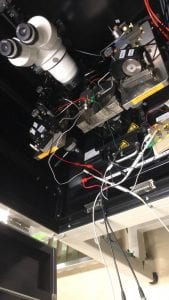
around Himeji, during which I got a call from Sahil! He ran into Gavin and Grace on their way back to the station. We met up, walked around some, and then went to wander around Umeda until he went back to Kyoto to have dinner with his parents. Japan is a huge country, and it’s funny how many times I’ve run into other fellows unexpectedly. We only have a few weeks left, but I look forward to the last few adventures in Japan.
Research Project Update
We have a working device!!! This week, we tested our Pseudo-CMOS circuit on its own, with an AC signal, an AC signal with a band pass filter, and with our pressure sensor. Our setup for measuring AC/real time signals is almost comically complex—our probes (and accompanying software) aren’t equipped for time dependent signals, so we have an external oscilloscope, voltage source, and function generator (in addition to our capacitor and resistor) connected to our device. I definitely spent a decent chunk of the week sitting on the floor taking data (the most efficient and effective way to make adjustments without bumping our setup), which earned me many laughs from the people who entered the measurement room. However, to show for it we have some really cool data—Sugiyama-san and I were able to see ~5x signal amplification of our heart rate measured by our sensor when we connected it to our device.
This week has contained some lucky moments. After a day of collecting data from our transistor without negative feedback, we found a resistor value just high enough that we were able to (optimal is 1 GΩ, we thought the highest we had was 10 MΩ but found a 20 MΩ which ended up being enough, although we’re still trying to get a bigger one so we can optimize our circuit). While we did break our electrode again (twice), we were inspired by some similar devices that were nearby to tape a thicker wire to it as a short term fix until we could fabricate a new one. Next week (after we fabricate some more sensors) we’re going to try different capacitor values to optimize our cutoff frequency for heart rate signals and decide how we’re going to integrate all of our components. Sugiyama-San and Uemura-sensei haven’t don’t this type of integration before, so we’re all reading lots of papers to try to figure out the best way to connect everything without damaging our device.
Week 10: Reflections on Japanese Language Learning
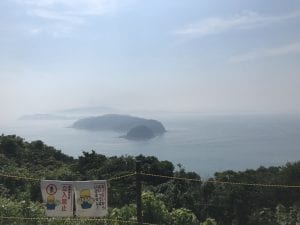
Monday I sat at my Uncle’s dining room table talking with and listening to my family. One of my uncles turned to me and asked, “How much do you understand? 10 percent?” I laughed and responded maybe, although as I watched my cousins run around the living room and make jokes that went over my head, I realized that my maybe 10% is definitely much less. However, I’m glad that I could talk in Japanese with them at all, given that my vocabulary was limited to “こんにさこんにさは,” “ありがとう,” and “よろしくおねがいします” (All pronounced just a little bit incorrectly). Now, I can say (almost) that entire sentence in Japanese!
I have stopped accidentally buying plastic bags at the grocery store, have had a full conversation with someone on the train with minimal handwaving, and have learned enough kanji to navigate my lab equipment and computers. While I speak only some Japanese at my lab (most of the time people explain things to me in English to make sure there’s no confusion), I’ve tried to continue to speak Japanese as much as possible and practice it in the evenings and during transit (and have finally gotten through some of ハリーポッタ, after numerous read-throughs).
My Japanese is most certainly not flawless, and moments of confusion occur with almost comical frequency. While I haven’t encountered any situations where I couldn’t communicate with the person I was talking to, I have walked kilometers in the wrong direction before realizing I misunderstood a direction (or asked for the directions to the wrong place). My biggest challenge with communication has been less language-based and more cultural based, with my tendency to keep moving forward through exhaustion and confusion. I’ve become more aware of what questions imply, rather than what they would be taken for at face value, and have hopefully had fewer instances of miscommunication with the people I encounter.
Regardless, I don’t want to stop learning Japanese after I return home. While I am unable to take a Japanese class next semester, I’m going to try to be more involved in my school’s Japanese Culture Association and participate in events at the Japanese Language House. I’ll keep reviewing and trying to expand my vocabulary and improve my grammar.
Life in Japan
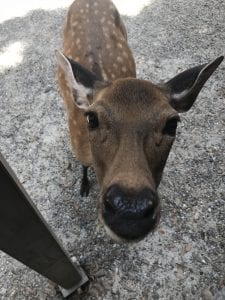
Monday we had the day off for Marine Day, so I had the chance to travel down to Wakayama and meet my family! Everyone congregated at Kyoichi-ojisan’s house, and it was so cool getting to talk with and learn about them. One of my cousins showed me her art, and it was incredible beyond words. Her husband and my other cousin introduced me to some really cool bands (that I’ve been listening to nonstop since), and my Ojisan taught me calligraphy (and how to write my name in Kanji). He also played a few songs on an electric piano that was the most insane thing I’ve ever seen—each hand plays a different instrument, and the foot that isn’t using the traditional piano pedals plays a third.
I’m so glad I had a chance to meet them. All of them are incredibly kind and were so welcoming. I’m also happy that I had a chance to meet Noboru-ojisan, who has checked in on me through all of the earthquakes, heatwaves, and flooding that has occurred this summer. He’s so funny and warm (which seems to be a shared trait of my extended family), and I hope my mom has a similarly good time reuniting with the rest of the Nishinaka-clan in Washington next week.
This weekend, I went to Shintenno-ji Temple for the monthly market and then met Sahil and Janmesh and Fushimi Inari for Motomiya-sai. It was my first time being at a festival after dark, and it was insane. There were people playing taiko, lanterns everywhere, and the already regularly crowded shrine was packed. It was so fun watching and participating in the celebration while catching up with Sahil and Janmesh. It’s weird to process that in a few weeks we’ll all be back in the US and hundreds of miles apart, unable to easily meet up to attend a matsuri or grab food together.
Sunday I made it to Nara before realizing that I left my Japanese phone (and thus, my easy way to get unlost) on its charger. While Nara is so well marked in English that I can hardly take ownership for finding my way to Nara Park and all of the breathtaking temples, beautiful shrines, and friendly deer within it, I’m still amazed that I found my way there and back, and then somehow got to Uji and from Uji back home—especially since Uji is the first place where I walked more than a kilometer without seeing a Konbini (I nearly cried when I realized I made it back to the train station). Outside of research, becoming slightly less navigationally challenged is up there with being able to communicate in Japanese on the list of things that I’m most proud of this summer.
Research Project Update
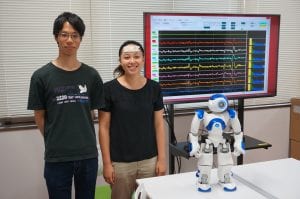
We are currently preparing to connect our pressure sensor and Pseudo-CMOS circuit to our wireless module. This past week, we fabricated two new pressure sensors and I created a few designs for how we can make all of our connections. The contacts on the wireless module are very small, so Namba-san is helping us attach wires to the ports we are using. Next week, we will first connect our pressure sensor directly to the wireless module to see if our signal is large enough without amplification, and then integrate our Pseudo-CMOS circuit. Our battery power is slightly higher than our test voltages, but hopefully it won’t damage our gate dielectric layer!
This week, I also had the opportunity to take alpha-wave measurements with Nao-kun (the robot Donald worked with two years ago). Brain wave measurements, and detection of small biosignals in general, is the “big picture” of my project and everything we do in Sekitani-sensei’s lab, so it was really cool to have the opportunity to work with the device and see (or at least, hear) it in action. Nao-kun relaxes when you do (it responds to the resulting higher-power of your alpha waves). Relaxing is harder than you might imagine it to be, since there is such a small difference in the amplitude of your relaxed and unrelaxed brain waves, and it’s really cool how we’re using organic electronic devices, like the Pseudo-CMOS circuit, to amplify and detect these small differences.
Question of the Week
Why is it so uncommon for Japanese students to study abroad? (or, is it unusual that so many American students have this experience?)
- Did you know that nationally just 325,339 U.S. students study abroad per the most recent IIE Open Doors Report? This seems like a lot but it actually represents just 1.6% of U.S. college students and 10% of college graduates. So, while it may seem like ‘a lot’ of U.S. students study abroad, the vast majority still do not.
- For more on how U.S. study abroad trends compare with study abroad trends in Japan see the section on Why International Research? on our Intercultural Communication and Skills page.
Week 11: Interview with Japanese Researcher
I interviewed my mentors, Uemura-sensei and Sugiyama-san. The transcriptions are below.
Uemura Sensei
Career Background: I have my Ph.D. in Engineering. I chose this field because I like to fabricate devices, and want to make something new to surprise new people. Up until now, I have been very lucky because in Japan it sometimes takes a very long time to carry up—you usually stay at each step along the way a very long time (after starting a postdoctoral position, it takes 3-5 years to become an assistant professor). It took me around three years to become an assistant professor, and each step has been very smooth. Four years ago I was a lecturer at Tokyo, and by chance I met Sekitani-sensei in the bathroom. We started talking, and eventually he offered me a job. Of course, I worked very hard, wrote many papers, and did my best. The most important things sometimes are connections and luck. Now I want to organize my own group: in Sekitani-lab, I’m number two, but I want to step up to organize my own team at a national research institute.
Lab Experience: I have never been to the US but I worked in a Belgian lab. Japan is not good compared to European research because Japanese researchers have too many duties compared to European researchers. They don’t have as much time to spend on research because they are expected to go to too many domestic conferences. Many older Japanese researchers are used to having these conferences and want to hold them, so younger people are forced to join.
Perspective on International Research: We currently have two Austrian researchers visiting our lab, and foreigners sometimes come to do research, but the lab is mostly Japanese. I did research for three months at Cambridge studying carrier transport in organic semiconductors. The research level was very high and I was very young, so I was learning as I was conducting the research. As mentioned earlier, I conducted research in Belgium. It was a very different situation—I knew much more, and it was a more equivalent collaboration. It was a very good experience. International collaboration is very important. Development of science and engineering is not local, but worldwide, and it is good to see how research is done. However, it is important to watch where you go. It is important to have friendship and trust in a cross collaboration, and the level of research, people involved, and area should be considered. We are able to take visiting students from Rice because Sekitani-sensei has a good relationship with Kono-sensei. It is very important to consider this relationship.
Research in the U.S. vs. Research in Japan: That depends on the meaning of the process, but in my opinion, the situation for research is better in the US than in Japan. The quality and education level is the same, but the situation is good in the US because there is more flexibility. Good researchers want to go to the US because there is good human resources and a much more flexible schedule. This environment makes better quality research. The different environment makes a big difference.
In opposite way, good researchers don’t want to come to Japan because it is more difficult to make communication, especially in the office, so it is very hard to do anything with the researcher. Also, maybe a normal stereotype answer, but Japanese students are maybe not so aggressive. In international conferences, foreign students are always asking my questions, but I never receive any from Japanese students.
Advice to a Young Researcher: Always do your best and always take leadership. Think about yourself and by yourself.
Sugiyama-san
Career background: I am studying applied physics. I like to learn lots of things, and it provides a wide range, including electrical engineering, physics, and optical engineering. I want to apply what I learn to the real world and build medical devices. Right now I am applying to the Osaka University Ph.D. program. Afterwards, I don’t know if I want to go into academia or industry.
Lab Experience: I have never been to the US, but last year I did research at a lab in Beijing. The biggest difference was how to do research. Japanese researchers try many different methods to optimize their research, work very hard, and try all paths to get their result. In Beijing people did not try all possibilities. They think about the project before starting and outline their paper before beginning research. They decide the story of the paper before starting their research, instead of the other way around. Both methods are good. I like to do research, so Japanese way is good, but I also like the way they do research in Beijing because I like to get results.
Perspective on International. Research: I did research last year in Beijing. Not many Japanese students travel for research, so this was a very special experience. I think it is important because I want to work with foreigners and people from different countries and cultures.
Research in the U.S. vs. Research in Japan: Japanese researchers work very long hours. Dedicated professors and Ph.D. students work from 9am-12pm instead of 9am-5pm. Osaka University students are smart and cool. They work hard, but I hear that students in the US might work harder.
Advice to a Young Researcher: Never compromise—it is good to study even when not in class/after finish topic. Don’t stop learning just because you aren’t being tested
Reflections on Interviews
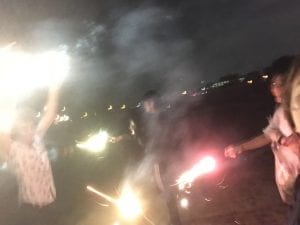
I had never really thought about exchanging students as a way to maintain a relationship between labs. In retrospect it makes sense: it facilitates collaboration between both groups while allowing the student to gain new research and collaboration skills. Additionally, both PIs can benefit from sharing research and having someone who is very familiar with how both groups conduct it. If a relationship exists, the PIs also can know that the student will probably have a good experience and make significant contributions to the lab.
I also never realized how demanding conference schedules are in Japan. While I know that many people in my lab have gone to conferences while I have been here, there are so many people in it that I did not realize the implication until Uemura-sensei mentioned it. It’s good to talk about your research. However, if you have to go to conferences all the time, it might be difficult to have time to conduct research to talk about. Maybe that’s why some people work such long hours here?
I related a lot to what Sugiyama-san said about why he wanted to do applied physics, and, after our interview and following conversation, I have been reflecting a lot on what I think I want to specialize in, and how I want to tackle the last two years of my undergraduate degree. I have been spending many of my evenings reading about optoelectronics and photonics, and finally registered for the digital electronic class I’ve been thinking about since March. I’m still not sure where I’ll end up in two years, but hopefully until then (and after) I’ll continue to learn as much as I can about physics, electronics, and engineering. I know that I definitely don’t want to leave the field behind.
Research Project Update

This week, we successfully delaminated our Pseudo-CMOS circuit! While we tore one of the devices, we were able to delaminate a portion of the sheet with multiple amplifiers since we were only interested in the Type-D (6:1) circuit (each sheet that we fabricate has two different types with two different channel lengths, for four circuits in total). We have made connections to our chip-capacitor, chip-resistors, and external contact points with gold wire, and so far everything is operational. Before we connected the whole setup, we tested the behavior of the sensor when it was connected directly to the wireless module. While the signal was small (~3 mV), we were able to successfully measure it without the amplifier circuit, demonstrating the sensitivity of the PVDF film. We were also able to greatly decrease the noise by connecting our reference to ground, which eliminates the need to have one’s arm in contact with a ground source.
The moment of truth came Friday morning when our silver paste dried and we were able to determine the functionality of our device! It works! We did see some unexpected behavior. Usually, when we conduct measurements, we have apply pressure to the top surface of our sensor in order to register a signal. However, when we did this without fully integrated device, we saw substantial clipping. This could be due to our capacitance value cutting off an important frequency in our pulse transmission or a general imbalance between our capacitance, resistance, and VDD values. Our drain voltage supplied by the battery on the wireless module is greater than we tested, and while it did not break our gate dielectric, it could be having adverse effects on our device performance. Also, we generally want to tune our resistor value since, from simulation, our optimal resistance should be around 1 GΩ, but the biggest resistor we have is 10 MΩ (although we can still see amplification with 20 MΩ resistance).
Not all of the unexpected behavior was negative. We now don’t need pressure to measure a signal! While the signal is small (around 4 mV, a slight improvement to the unamplified signal), this is a huge improvement from no signal at all. I really hope to have the chance to play around with the resistor and capacitor values before I have to leave next week, but I also know that time is starting to run out. Hopefully there’s an easy way for us to swap out our resistors and capacitors—I’m currently wracking my brain to try to determine the best way without damaging our device, given that we only have one and by the time I finish a new one it will be time to hop on a train back to Tokyo. I know that the sensor area and orientation can also be improved from how we currently have it to wrap around the wrist. I already have a shadow mask for one that might yield a better signal, so maybe I’ll get a chance to fabricate and test it before the end of next week! Regardless, I look forward to hearing updates from my labmates after I’m gone.
Once we optimize our sensor, our next step will be to eliminate motion artefacts. This will probably largely be done algorithmically. When I first noticed how movement corrupts our signal at the beginning of the summer, I started looking into different methods to deal with this issue. While I have some basic code, there are some algorithms I would like to try to write and apply. Again, I know that there’s only a week left, but at the very least it’s something I can share with my mentors if they continue to move forward on the project.
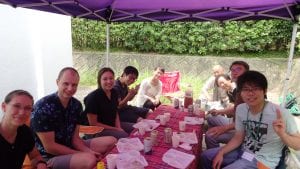
As things wrap up for me in lab, the spring semester is also wrapping up Japanese students. On Saturday, we had our summer barbeque. I’m so glad I had the chance to go! It was very fun hanging out with everyone in the lab and getting a chance to talk with the lab members that I don’t cross paths with as frequently. That evening, I met up with some of the Kyoto-area Japanese Fellows and U.S. Fellows to celebrate the end of classes (and the near end of exams). It was bittersweet, since it means that we will be gone soon, but I am excited for the Japanese Fellows to come to the US.
Question of the Week
In Japan, is there an equivalent or similar superstition to saying “bless you” or “gesundheit”?
- No, its customary for people just to ignore or not say anything when someone sneezes in Japan. It’s a pretty American tradition though there are other countries that some some responses to when people sneeze too.
Week 12-13: Final Week at Research Lab & Re-Entry Program
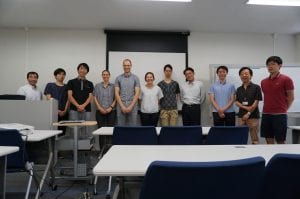
My final week was a whirlwind. Since a few of my mentors were traveling during the week, I gave a wrap-up talk on Monday summarizing all of the work that I did this summer. A ton of people from my lab came to listen which was really cool—even Sekitani-sensei took time out of his busy schedule to attend! Everyone asked some really interesting questions that will inform where my project ends up going. Sekitani-sensei wants us to use the device to control Nao-kun to demonstrate the interface between our heart rate monitor and robotics. I unfortunately ran out of time to finish it myself, but adjusting the software to respond to changes in heart rate is something that my lab will continue to work on in addition to optimizing the impedance and minimizing motion artefacts.
My last few days I spent analyzing some last pieces of data and finishing my presentations. Friday was full of lots of hard goodbyes: I met so many incredible people, and it’s insane that I’m back to living thousands of miles away from them. Before I left, my whole lab gathered together for teuchi. It was a farewell, but more of a また ね than a さよなら: I will hopefully see the people in my lab again sometime soon, whether it be during a return trip to Japan or at an international conference.
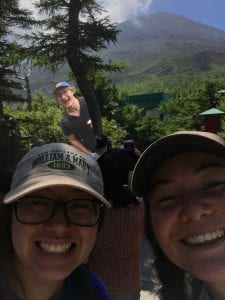
During my final weekend in Japan, I climbed Fuji-san with almost all of the other US fellows. The climb, like my summer, was both arduous and fun. I had to learn to adjust to different terrains that composed the mountain path, and, while I was sometimes slower on some surfaces, I figured out how to tackle them (often with the help of others). I met some really cool people during each, and made it to the top in one piece (only slightly freezing) in time for the sunrise. The trip down in a way was almost harder than the climb up, but again I had my friends to support the transition down the mountain.
Re-Entry Program at Rice University
Tuesday afternoon we touched down in Houston, and each of us flinched as the American flight attendant welcomed us with an enthusiastic “GOOD AFTERNOON, WELCOME TO HOUSTON.” We shuffled our way off the plane, offering “すみません’s” followed by stuttered “sorry, excuse me’s” as our sleep addled brains had not yet switched back over to English. Strangers talked on the elevator; I kept (and still) looked the wrong way before crossing the street. It felt weird to walk around at night. We definitely were not in Japan anymore.
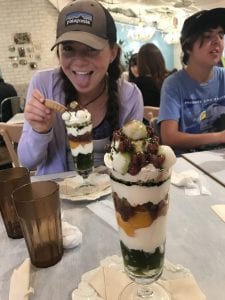
Beyond the quiet and the cleanliness, one of the biggest differences I noticed was the feeling of safety. Perhaps I felt less safe in America because for almost twenty years, I’ve been told that I cannot walk alone at night, and should still be cautious in the daylight. In American media we’re constantly shown and warned about violence. Perhaps this is unnecessary, and we live in greater fear than we need to. But at the same time, this was my first semester-long duration of time where I did not receive a notification of shots fired on or around the campus I was living on. Every time I, or one of the other fellows, lost something in Japan, it was always returned.
It was also interesting to see the differences between American and Japanese politeness. American polite is loud: it’s starting a conversation with strangers, asking if someone needs help or more space, and offering water to someone struggling up a mountain. Japanese polite is more quiet: it’s standing up on a crowded train so someone can take their seat, fanning someone freaking out because they got on the wrong train to Mt. Fuji and won’t make it in time (whoops), and walking a lost person to the location they are trying to get to. Social rules vary by region in each country, with the south being more “friendly” and “loud” in both. In some ways, returning to Tokyo was almost a bigger culture shock than returning to the US, because I was prepared to be overwhelmed by the differences in the US, whereas I was unprepared for the harsher, fast pace of the more northern city. I was always walking on the wrong side of the road and into other people, wishing that I could return to the Kansai region for forever (a sentiment that continues to hold back in VA).
Reflections on the Overall Program
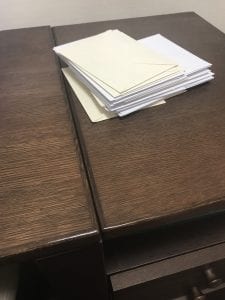
It was hard to leave because of the research, cool experiences, and even cooler people, but it was also hard to leave because I grew so much while I was there (a very stereotypical sentiment, but true nonetheless). Between daily frustrations in never having enough words (speaking or reading, rip those three bottles of vinegar I did not mean to buy), sometimes feeling like an outsider, and never knowing enough, I learned to use the words I had to convey or understand a point. There were labmates, family, and strangers that made me feel like I belonged, and 35 mentors in my lab that taught me so much and encouraged me to keep on learning. As Sarah expressed she hoped we would do during one of the first times we met her, I learned to say “yes,” and swallow my fears so I could have some amazing experiences. I found a balance between working hard and appreciating the culture and environment I was in, how to get lost and find my way again, recognize when I was not operating at my best and needed sleep or food, and met incredible family members that I had only ever heard stories about. I learned how to fabricate electronic devices and came to better understand transistors and their applications.
Some other unexpected changes were my two allergic reactions during the re-entry program, so there’s definitely some more personal learning and growth I need to undergo in learning to not eat things I’m allergic to, although it was an ironic bookend to the beginning of the program where I ate soba (which is not made from buckwheat, whoops indeed). Besides my two dietary mistakes, the re-entry program was a difficult end to the summer. We nostalgically reminisced the things we would miss about Japan, but also expressed excitement for things about being back in the U.S. that we missed in Japan, like trashcans and our families. We had some very helpful conversations about graduate school, and it was interesting to see how many of our interests had shifted since the beginning of the summer. Many more of us were thinking about graduate school, and our interests were either much more or much less aligned with the research we did this past summer. I was very thankful for the last week I had with the other fellows, and it was hard to say goodbye: however, this, too, felt more like a また ね than a さよなら, and I am excited to see them all again in the future.
Final Question of the Week
How long will it take for small things to start feeling normal again, like looking the right way to cross the street or walking on the right side of the sidewalk?
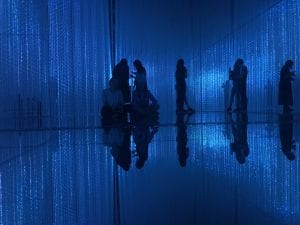
Final Research Overview and Poster
Final Presentation at Closing Ceremony in Tokyo
The final presentation was probably the most stressful one I gave, since we all thought we had six minutes to talk, but only had five. However, we hopefully didn’t speed through our talks too quickly (most of us definitely went over), but it was really cool to hear the final product of everyone’s research. It was also definitely a lesson in preparedness, and in the future I will try to better tailor my talks so that I can more effectively adjust them if there’s every a change in length.
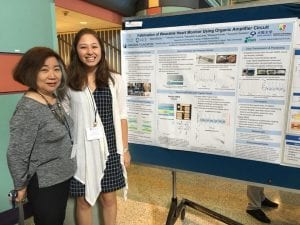
Poster Presentation at the Smalley-Curl Institute (SCI) Summer Research Colloquium
The SCI Colloquium was a really neat opportunity to learn about what students at Rice were studying, and it was nice to talk to the judges and the people who came over to my poster. I also got to see some family in Houston that I haven’t seen in years—my Aunt and Uncle came to see the posters and some of the talks, and it was nice to connect with family in both America and Japan this summer!
After our re-entry program, I have reevaluated how I usually give poster talks, and adjusted it for the presentation. Hopefully my poster presentations will become more and more effective!
Research Abstract and Poster:Fabrication of Wearable Heart Monitor Using Organic Amplifier Circuit (PDF)
Host Lab in Japan: Osaka University – Inst. of Scientific & Industrial Research, Advanced Electronic Devices, Sekitani Laboratory
Host Professor: Prof. Tsuyoshi Sekitani
My project was the Fabrication of a Wearable Heart Monitor Using an Organic Amplifier Circuit, which I conducted in Sekitani Lab at Osaka University under the mentorship of Professor Takafumi Uemura and Masahiro Sugiyama. An important development in the field of electronics is creating an “internet of things” by having an interface between devices such as a smartphone or smart watch, sensors that detect natural disasters, and health monitoring systems. My device is intended to match this interface by being a lightweight health monitoring system that can be inexpensively fabricated and easily worn to track heart rate in order to detect things like heart failure, heart disease, and safe exercise. This is particularly important in an aging population with reduced access to medical care, so it can fill a need for remote medical care while still being utilized by athletes without cumbersome or unreliable equipment.
Organics specifically are interesting for my device due to their flexibility and solubility, so the device can be fabricated via inkjet processes for inexpensive large area fabrication, although I used vacuum deposition to fabricate my device since I only made a few copies of each component. I utilized polyvinylidene fluoride, a piezoelectric film, with an aluminum electrode deposited on either side as my pressure sensor, and a type-D (6:1) Pseudo-CMOS amplifier with a parylene gate dielectric and DNTT organic semiconductor to amplify the detected signals. These were interfaced with a wireless module so that signals could be processed remotely and the device could be interfaced with other electronics. We saw successful signal detection, and could measure heart rate without securing the sensor, indicating that we were able to create a comfortable, inexpensive, wearable device.
Moving forward, we need to tune and optimize our impedance to maximize our amplification and minimize motion artefacts, given that there is an effect seen when the surface the device is on is moved. Additionally, we want to demonstrate that we can track heart rate accurately enough to control Nao-kun the robot, and need to adjust our code accordingly.
Follow-on Project
I haven’t solidified my follow-on project yet, but I plan to present my poster at PhysicsFest, an event in my department at the College of William & Mary every year where it’s opened up to students, alumni, and members of the community. I also want to apply to the Gulf Coast Undergraduate Research Symposium (GCURS), and will talk to the Reeves Center for Study Abroad at my university about whether or not I can also host a table at the study abroad fair in the winter.
Tips for Future Participants
Pre-Departure Tips
- If you aren’t already learning Japanese, start studying before you leave! Any vocabulary is helpful, and, while you won’t become fluent in two months, it will make language classes much less stressful and overwhelming.
- Also, I wish that I planned where I wanted to go more before leaving: I wanted to travel more than I did, but didn’t look into things like a Japan Rail Pass or Regional Passes or really figure out what I wanted to do until I was already there. It worked out, but I think I would have seen more if I had a better idea of what I wanted to do going in.
- Also, pack good walking shoes! Especially during the orientation period (and depending on what type of exploring you like to do), I was walking 8+ miles a day, and mine literally fell apart. Alternatively, there are some really cool sneaker stores in Japan, so you can try to wait until you get there to find shoes if your feet aren’t too big.
Preparing for Research Abroad
- Read and learn as much as you can, and be open-minded and enthusiastic! It’s hard to prepare absolutely, but as long as you’re excited about research and willing to learn (both about the science and the culture) then you should have a great experience.
What Gifts to Bring
- Bring something small that represents your region and is easy to pack. Everyone will be happy that you brought something at all—things like chocolate or individually wrapped biscuits are great since it’s easy to pack and pretty much everyone likes chocolate.
Orientation Program in Tokyo
- Orientation is exhausting, but it’s also a lot of fun.
- Don’t be afraid to talk to the speakers and the other fellows.
- Use free time to travel and explore: however, don’t be afraid to take a free afternoon off to sleep or relax. You’re super busy and doing stuff nonstop, so it’s important to take care of yourself!
Mid-Program Meeting In Kyoto
- I did not sleep, and ended up with a 220 V rice cooker and no plans to travel to China or the UK (the only places a 22V appliance will work) because I went shopping when I was too tired.
- At the same time though, this is your last organized chance to be with all of the US and Japanese fellows, so make sure to spend time with them and explore!
- Kyoto is a really cool city: if you’re not in Kyoto, you’re probably going to be in an equally cool city. Get there early to check it out, explore in the evenings, and (if you have time) explore Kobe after the Sysmex visit.
Working With your Research Lab Tips
- I can be shy, and one of the things I struggled with the most was to break out of my shell to get to know my lab mates better. Don’t be afraid to talk to the people around you, share food, or invite someone to lunch. Sometimes they’ll be busy, and that’s ok: everyone has lots to do. However, people are generally pretty friendly and want to get to know you as much as you want to know them. Everyone is nervous at first meetings, but once you get over that hurdle, friendship (or at least, acquaintanceship) is imminent.
- It might be a while before you’re here again or doing the same kind of research. Be excited to learn inside of lab and out. Every lab and every experience is different, and a lot of it can be driven by your attitude. Sometimes you’ll have a lot of downtime: use that time to study something relevant and interesting, or work on honing a skill that you’ve always wanted to acquire.
- You have incredible mentors surrounding you, some of whom have been in a similar position to the one that you’re in currently, and they’re so excited to teach and learn from you.
Living in Osaka
- Depending on what campus you’re on, you have different opportunities and experiences. If you’re living on the undergraduate campus (Tonyaka Campus), join a club! Meet some other undergraduates! If you’re on Suita Campus, check out the international center! There aren’t as many people that live there, so it’s pretty quiet at night, but it’s a nice place to walk around and explore, and you can still meet people through organized events in different centers. If you’re on Minoh campus, let me know how it is! I’ve never been, but I’m sure it’s great!
Language Study Tips:
- I found flashcards and quizlets really helpful (let me know if you want my quizlet with all of the class 2 vocab), and tried to speak in Japanese as much as possible (and asked a lot of questions when I wasn’t sure what words are).
- There’s also a free language class offered by the international center at Osaka University—you can look at your schedule and talk to your mentor if you’re interested in attending.
- Also, pick a favorite word! So many people asked me, and I had no idea what to say.
What to Eat in Japan
- Everything? Pretty much everything.
- If you have allergies, definitely make sure to look things up beforehand (don’t spend your first week in Japan confused as to why you feel so terrible).
- Try the weird or delicious looking food—go on an adventure on a food street, it’s all pretty good and you’ll hopefully have minimal regrets.
What to Buy in Japan
- There’s so much good food. Also, you don’t necessarily need to pack things like crocs or indoor shoes, since you can find them for pretty cheap at a hyaku-en store (108JPY, to be exact).
- Also, a great investment is a tenugui, since they’re really cute and it’s very, very hot so you might be a little sweaty. (They’re also great for bathrooms without hand towels or air dryers).
- A multitool can be helpful if you didn’t pack one, and depending on what region you’re in (or just to reduce your use of plastic bags) you might want to buy a reusable shopping bag. Especially in Kansai, some grocery stores charge for plastic bags, and you can find both of these things at a hyaku-en store. I already miss those so much.
What to Do in Japan
- Explore! Again, “Just say yes.”
- Try something new: you can decide afterwards whether or not it’s something you would like to do again.
- Check out what interests you, whether this be cultural sites, technology hubs, or something else entirely! But, also visit somewhere you wouldn’t usually plan to go.
- Be flexible and willing to try new things or change plans. Sometimes things are closed or don’t work out, but treat this as an opportunity to try something else instead of a loss.
